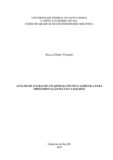| dc.contributor.advisor | Santos, César Gabriel dos | |
| dc.creator | Vizzotto, Jéssica Dotto | |
| dc.date.accessioned | 2019-12-19T13:34:19Z | |
| dc.date.available | 2019-12-19T13:34:19Z | |
| dc.date.issued | 2019-07-11 | |
| dc.date.submitted | 2019-07-11 | |
| dc.identifier.uri | http://repositorio.ufsm.br/handle/1/19187 | |
| dc.description.abstract | The advance in the agribusiness of Brazil is of great influence for the development of the country. The increase in grain yield, the control of spontaneous plants and the diversification of income are factors that promote searches for crop alternatives. For this, the incorporation of rainfed agriculture, such as soybean and corn, in rotation with the irrigated rice production system in lowland areas, becomes an opportunity for improvement. However, the lack of implements that fully meet this function creates greater difficulties for farmers. As a result, agricultural equipment was developed through empirical knowledge and "trial and error" in order to facilitate the implementation of the furrow system. This system helps soil drainage during high rainfall levels and makes it possible to flood irrigation in rainfed agriculture in periods of drought, reducing the damages that these weathers can cause. Thus, the present work aims to identify potential failures and to analyze the risks of an agricultural prototype subsystem for the furrow-ridge implementation. For this, a survey was carried out in catalogs and online platforms in order to know agricultural implements available in the market and, also, a search of antecedents in the Questel Orbit commercial software to identify the registered products. In addition, the FMEA design tool was used in the main components of the chosen subsystem, indicating the parameters of gravity, probability of occurrence and detection, in which it was possible to analyze the possible failure modes and their effects together with proposals for improvements to the subsystem. Both the research in catalogs and online platforms, as well as the search carried out by the software, made possible the knowledge of different systems for agricultural use, however, none that was effectively similar to the one proposed in the work. With the analysis of the main components of the system, the disc blades was the one that presented the greatest risk, since its failure prevents the system from operating correctly. | eng |
| dc.language | por | por |
| dc.publisher | Universidade Federal de Santa Maria | por |
| dc.rights | Acesso Aberto | por |
| dc.subject | Implemento agrícola | por |
| dc.subject | Cultivo de soja | por |
| dc.subject | Agronegócio | por |
| dc.subject | Agricultural equipment | eng |
| dc.subject | Design FMEA | eng |
| dc.subject | Soybean production in lowland areas | eng |
| dc.title | Análise de falhas de um sistema técnico agrícola para implementação sulco-camalhão | por |
| dc.title.alternative | Analysis of failures of an agricultural technical system for furrow-ridge implementation | eng |
| dc.type | Trabalho de Conclusão de Curso de Graduação | por |
| dc.degree.local | Cachoeira do Sul, RS, Brasil. | por |
| dc.degree.graduation | Bacharelado em Engenharia Mecânica | por |
| dc.description.resumo | O avanço no agronegócio do Brasil é de grande relevância para o desenvolvimento do país. O aumento na produtividade de grãos, o controle de plantas espontâneas e a diversificação da renda são fatores que promovem buscas por alternativas de cultivo. Para isso, a incorporação de culturas de sequeiro, como a soja e o milho, em rotação com o sistema produtivo de arroz irrigado em áreas de várzea, torna-se uma oportunidade de melhorias. Entretanto, a falta de implementos que atendam plenamente essa função geram maiores dificuldades aos agricultores. Em virtude disso, desenvolveu-se um equipamento agrícola através de conhecimentos empíricos e “tentativa e erro” a fim de facilitar a implementação do sistema sulco-camalhão. Esta sistemática auxilia na drenagem do solo durante altos índices pluviométricos e torna possível a irrigação por inundação no cultivo de sequeiro em períodos de seca, diminuindo os prejuízos que essas intempéries podem causar. Assim, o presente trabalho tem como objetivo identificar as falhas potenciais e analisar os riscos de um subsistema de protótipo agrícola para a implementação sulco-camalhão. Para isso, foi realizada uma pesquisa em catálogos e plataformas online a fim de conhecer implementos agrícolas disponíveis no mercado e, também, uma busca de anterioridades no software comercial Questel Orbit para identificar os produtos registrados. Além disso, foi utilizada a ferramenta FMEA de projeto nos principais componentes do subsistema escolhido indicando os parâmetros de gravidade, probabilidade de ocorrência e de detecção, no qual possibilitou a análise dos possíveis modos de falha e seus efeitos juntamente com propostas de melhorias para o subsistema. Tanto a pesquisa em catálogos e plataformas online, quanto a busca realizada pelo software, possibilitaram o conhecimento de diferentes sistemas para o uso agrícola, porém, nenhum que se assemelhasse efetivamente ao proposto no trabalho. Com a análise dos principais componentes do sistema, o disco de corte côncavo recortado foi o que apresentou maior risco, uma vez que sua falha impede que o sistema opere corretamente. | por |
| dc.publisher.country | Brasil | por |
| dc.publisher.initials | UFSM | por |
| dc.subject.cnpq | CNPQ::ENGENHARIAS::ENGENHARIA MECANICA | por |
| dc.publisher.unidade | UFSM Cachoeira do Sul | por |


